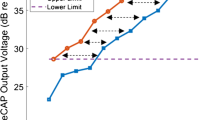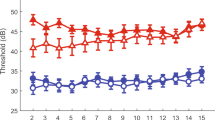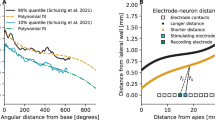Abstract
There are a number of psychophysical and electrophysiological measures that are correlated with SGN density in animal models, and these same measures can be performed in humans with cochlear implants (CIs). Thus, these measures are potentially applicable in humans for estimating the condition of the neural population (so called “neural health” or “cochlear health”) at individual sites along the electrode array and possibly adjusting the stimulation strategy in the CI sound processor accordingly. Some measures used to estimate neural health in animals have included the electrically evoked compound potential (ECAP), psychophysical detection thresholds, and multipulse integration (MPI). With regard to ECAP measures, it has been shown that the change in the ECAP response as a function of increasing the stimulus interphase gap (“IPG Effect”) also reflects neural density in implanted animals. These animal studies have typically been conducted using preparations in which the electrode was in a fixed position with respect to the neural population, whereas in human cochlear implant users, the position of individual electrodes varies widely within an electrode array and also across subjects. The current study evaluated the effects of electrode location in the implanted cochlea (specifically medial-lateral location) on various electrophysiological and psychophysical measures in eleven human subjects. The results demonstrated that some measures of interest, specifically ECAP thresholds, psychophysical detection thresholds, and ECAP amplitude-growth function (AGF) linear slope, were significantly related to the distances between the electrode and mid-modiolar axis (MMA). These same measures were less strongly related or not significantly related to the electrode to medial wall (MW) distance. In contrast, neither the IPG Effect for the ECAP AGF slope or threshold, nor the MPI slopes were significantly related to MMA or MW distance from the electrodes. These results suggest that “within-channel” estimates of neural health such as the IPG Effect and MPI slope might be more suitable for estimating nerve condition in humans for clinical application since they appear to be relatively independent of electrode position.











Similar content being viewed by others
References
Abbas PJ, Hughes ML, Brown CJ, Miller CA, South H (2004) Channel interaction in cochlear implant users evaluated using the electrically evoked compound action potential. Audiol Neuro-otol 9:203–213
Abbas PJ, Brown CJ, Shallop JK, Firszt JB, Hughes ML, Hong SH, Staller SJ (1999) Summary of results using the nucleus CI24M implant to record the electrically evoked compound action potential. Ear Hear. 20:45–59
Bates D, Maechler M, Boker B, Walker S (2015) Fitting linear mixed-effects models using lme4. J. Stat. Softw. 67:1–48
Bierer JA (2007) Threshold and channel interaction in cochlear implant users: evaluation of the tripolar electrode configuration. J Acoustic Soc Am 121:1642–1653
Bierer JA, Faulkner KF (2010) Identifying cochlear implant channels with poor electrode-neuron interface: partial tripolar, single-channel thresholds and psychophysical tuning curves. Ear Hear. 31:247–258
Carlyon RP, Cosentino S, Deeks JM, Parkinson W, Arenberg JA (2018) Effect of stimulus polarity on detection thresholds in cochlear implant users: relationships with average threshold, gap detection, and rate discrimination. J Assoc Res Otolaryngol
DeVries L, Scheperle R, Bierer JA (2016) Assessing the electrode-neuron interface with the electrically evoked compound action potential, electrode position, and behavioral thresholds. J. Assoc. Res. Otolaryngol. 17:237–252
Earl BR, Chertoff ME (2010) Predicting auditory nerve survival using the compound action potential. Ear Hear. 31:7–21
Felix H, Pollak A, Gleeson M, Johnsson LG (2002) Degeneration pattern of human first-order cochlear neurons. Adv. Otorhinolaryngol. 59:116–123
Finley CC, Holden TA, Holden LK, Whiting BR, Chole RA, Neely GJ, Hullar TE, Skinner MW (2008) Role of electrode placement as a contributor to variability in cochlear implant outcomes. Otology & neurotology : official publication of the American Otological Society, American Neurotology Society [and] European Academy of Otology and Neurotology 29:920–928
Goldwyn JH, Bierer SM, Bierer JA (2010) Modeling the electrode-neuron interface of cochlear implants: effects of neural survival, electrode placement, and the partial tripolar configuration. Hear. Res. 268:93–104
Hall RD (1990) Estimation of surviving spiral ganglion cells in the deaf rat using the electrically evoked auditory brainstem response. Hear. Res. 49:155–168
He S, Teagle HFB, Buchman CA (2017) The electrically evoked compound action potential: from laboratory to clinic. Front. Neurosci. 11:339
Hinojosa R, Marion M (1983) Histopathology of profound sensorineural deafness. Ann. N. Y. Acad. Sci. 405:459–484
Hughes ML, Goehring JL, Baudhuin JL (2017) Effects of stimulus polarity and artifact reduction method on the electrically evoked compound action potential. Ear Hear. 38:332–343
Hughes ML, Choi S, Glickman E (2018) What can stimulus polarity and interphase gap tell us about auditory nerve function in cochlear-implant recipients? Hear. Res. 359:50–63
Jahn KN, Arenberg JG (2019) Evaluating psychophysical polarity sensitivity as an indirect estimate of neural status in cochlear implant listeners. J Assoc Res Otolaryngol 20:415–430
Kang SY, Colesa DJ, Swiderski DL, Su GL, Raphael Y, Pfingst BE (2010) Effects of hearing preservation on psychophysical responses to cochlear implant stimulation. J Assoc Res Otolaryngol 11:245–265
Kuznetsova A, Brockhoff PB, Christensen RHB (2017) lmerTest package: tests in linear mixed effects models. J. Stat. Softw. 82:1–26
Lathuilliere M, Merklen F, Piron JP, Sicard M, Villemus F, Menjot de Champfleur N, Venail F, Uziel A, Mondain M (2017) Cone-beam computed tomography in children with cochlear implants: the effect of electrode array position on ECAP. Int. J. Pediatr. Otorhinolaryngol. 92:27–31
Long CJ, Holden TA, McClelland GH, Parkinson WS, Shelton C, Kelsall DC, Smith ZM (2014) Examining the electro-neural interface of cochlear implant users using psychophysics, CT scans, and speech understanding. J Assoc Res Otolaryngol 15:293–304
Nadol JB Jr (1997) Patterns of neural degeneration in the human cochlea and auditory nerve: implications for cochlear implantation. Otolaryngol--Head Neck Surg 117:220–228
Nehme A, El Zir E, Moukarzel N, Haidar H, Vanpoucke F, Arnold L (2014) Measures of the electrically evoked compound action potential threshold and slope in HiRes 90K(TM) users. Cochlear implants international 15:53–60
Pfingst BE, Xu L, Thompson CS (2004) Across-site threshold variation in cochlear implants: relation to speech recognition. Audiol Neuro-otol 9:341–352
Pfingst BE, Colesa DJ, Swiderski DL, Raphael Y, Schvartz-Leyzac KC (2019) Using detection thresholds to estimate cochlear health: single pulse vs. multipulse stimuli. In: conference on implantable auditory prostheses. Lake Tahoe, CA
Pfingst BE, Hughes AP, Colesa DJ, Watts MM, Strahl SB, Raphael Y (2015a) Insertion trauma and recovery of function after cochlear implantation: evidence from objective functional measures. Hear. Res. 330:98–105
Pfingst BE, Colesa DJ, Hembrador S, Kang SY, Middlebrooks JC, Raphael Y, Su GL (2011) Detection of pulse trains in the electrically stimulated cochlea: effects of cochlear health. J Acoustic Soc Am 130:3954–3968
Pfingst BE, Colesa DJ, Swiderski DL, Hughes AP, Strahl SB, Sinan M, Raphael Y (2017) Neurotrophin gene therapy in deafened ears with cochlear implants: long-term effects on nerve survival and functional measures. J. Assoc. Res. Otolaryngol. 18:731–750
Pfingst BE, Zhou N, Colesa DJ, Watts MM, Strahl SB, Garadat SN, Schvartz-Leyzac KC, Budenz CL, Raphael Y, Zwolan TA (2015b) Importance of cochlear health for implant function. Hear. Res. 322:77–88
Prado-Guitierrez P, Fewster LM, Heasman JM, McKay CM, Shepherd RK (2006) Effect of interphase gap and pulse duration on electrically evoked potentials is correlated with auditory nerve survival. Hear. Res. 215:47–55
Ramekers D, Versnel H, Strahl SB, Klis SF, Grolman W (2015) Temporary neurotrophin treatment prevents deafness-induced auditory nerve degeneration and preserves function. J. Neurosci. 35:12331–12345
Ramekers D, Versnel H, Strahl SB, Smeets EM, Klis SF, Grolman W (2014) Auditory-nerve responses to varied inter-phase gap and phase duration of the electric pulse stimulus as predictors for neuronal degeneration. J Assoc Res Otolaryngol 15:187–202
Rattay F (1999) The basic mechanism for the electrical stimulation of the nervous system. Neuroscience 89:335–346
Rattay F, Lutter P, Felix H (2001) A model of the electrically excited human cochlear neuron: I. Contribution of neural substructures to the generation and propagation of spikes. Hear. Res. 153:43–63
RCoreTeam (2018) R: a language and environment for statistical computing. Austria R Foundation for Statistical Computing, Vienna
Schvartz-Leyzac KC, Pfingst BE (2016) Across-site patterns of electrically evoked compound action potential amplitude-growth functions in multichannel cochlear implant recipients and the effects of the interphase gap. Hear. Res. 341:50–65
Schvartz-Leyzac KC, Pfingst BE (2018) Assessing the relationship between the electrically evoked compound action potential and speech recognition abilities in bilateral cochlear implant recipients. Ear Hear. 39:344–358
Schvartz-Leyzac KC, Colesa DJ, Buswinka CJ, Swiderski DL, Raphael Y, Pfingst BE (2019) Changes over time in the electrically evoked compound action potential (ECAP) interphase gap (IPG) effect following cochlear implantation in guinea pigs. Hear. Res. 383:e1–e15
Schvartz-Leyzac KC, Colesa DJ, Buswinka CJ, Hughes AP, Raphael Y, Pfingst BE (Submitted) Estimating neural health using the electrically evoked compound action potential (ECAP) in chronically-implanted guinea pigs The Journal of the Acoustical Society of America
Shepherd RK, Javel E (1997) Electrical stimulation of the auditory nerve. I. Correlation of physiological responses with cochlear status. Hear. Res. 108:112–144
Shepherd RK, Hatsushika S, Clark GM (1993) Electrical stimulation of the auditory nerve: the effect of electrode position on neural excitation. Hear. Res. 66:108–120
Skinner MW, Holden TA, Whiting BR, Voie AH, Brunsden B, Neely JG, Saxon EA, Hullar TE, Finley CC (2007) In vivo estimates of the position of advanced bionics electrode arrays in the human cochlea. The Annals of otology, rhinology & laryngology Supplement 197:2–24
Smith L, Simmons FB (1983) Estimating eighth nerve survival by electrical stimulation. The Annals of otology, rhinology, and laryngology 92:19–23
Teymouri J, Hullar TE, Holden TA, Chole RA (2011) Verification of computed tomographic estimates of cochlear implant array position: a micro-CT and histologic analysis. Otology & neurotology : official publication of the American Otological Society, American Neurotology Society [and] European Academy of Otology and Neurotology 32:980–986
The Mathworks I (2010) MATLAB. The MathWorks, Inc., Natick
The Mathworks I (2017) MATLAB. The MathWorks, Inc, Natick, Massachusetts, United States
Undurraga JA, van Wieringen A, Carlyon RP, Macherey O, Wouters J (2010) Polarity effects on neural responses of the electrically stimulated auditory nerve at different cochlear sites. Hear. Res. 269:146–161
van de Heyning P, Arauz SL, Atlas M, Baumgartner WD, Caversaccio M, Chester-Browne R, Estienne P, Gavilan J, Godey B, Gstöttner W, Han D, Hagen R, Kompis M, Kuzovkov V, Lassaletta L, Lefevre F, Li Y, Müller J, Parnes L, Kleine Punte A, Raine C, Rajan G, Rivas A, Rivas JA, Royle N, Sprinzl G, Stephan K, Walkowiak A, Yanov Y, Zimmermann K, Zorowka P, Skarzynski H (2016) Electrically evoked compound action potentials are different depending on the site of cochlear stimulation. Cochlear implants international 17:251–262
van Eijl RH, Buitenhuis PJ, Stegeman I, Klis SF, Grolman W (2017) Systematic review of compound action potentials as predictors for cochlear implant performance. Laryngoscope 127:476–487
Voie AH (2002) Imaging the intact guinea pig tympanic bulla by orthogonal-plane fluorescence optical sectioning microscopy. Hear. Res. 171:119–128
Wise AK, Pujol R, Landry TG, Fallon JB, Shepherd RK (2017) Structural and ultrastructural changes to type I spiral ganglion neurons and Schwann cells in the deafened guinea pig cochlea. J Assoc Res Otolaryngol 18:751–769
Zhou N, Pfingst BE (2014) Relationship between multipulse integration and speech recognition with cochlear implants. J Acoustic Soc Am 136:1257
Zhou N, Pfingst BE (2016) Evaluating multipulse integration as a neural-health correlate in human cochlear-implant users: relationship to spatial selectivity. J Acoustic Soc Am 140:1537
Zhou N, Xu L, Pfingst BE (2012) Characteristics of detection thresholds and maximum comfortable loudness levels as a function of pulse rate in human cochlear implant users. Hear. Res. 284:25–32
Zhou N, Kraft CT, Colesa DJ, Pfingst BE (2015) Integration of pulse trains in humans and guinea pigs with cochlear implants. J Assoc Res Otolaryngol 16:523–534
Acknowledgments
We would like to thank the subjects for their participation in the research, and we are grateful to the University of Michigan Cochlear Implant team for their support and assistance with subject recruitment.
Funding
These studies were funded by NIH NIDCD R01DC015809 and a University of Michigan MCubed grant.
Author information
Authors and Affiliations
Corresponding author
Ethics declarations
Conflict of Interest
The authors declare that they have no conflict of interest.
Additional information
Publisher’s Note
Springer Nature remains neutral with regard to jurisdictional claims in published maps and institutional affiliations.
Rights and permissions
About this article
Cite this article
Schvartz-Leyzac, K.C., Holden, T.A., Zwolan, T.A. et al. Effects of Electrode Location on Estimates of Neural Health in Humans with Cochlear Implants. JARO 21, 259–275 (2020). https://doi.org/10.1007/s10162-020-00749-0
Received:
Accepted:
Published:
Issue Date:
DOI: https://doi.org/10.1007/s10162-020-00749-0




